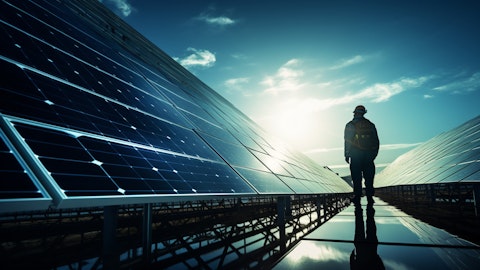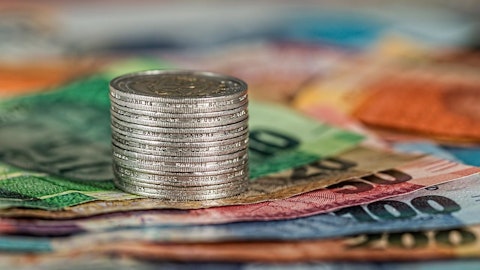Alan Lau: Okay. Understood. So the next question is regarding to some of the — appears to be one-off income in this quarter. So like the other income is actually surged quarter-by-quarter. So I wonder if that’s related to a disposal of our gain in our Xinjiang capacity and how much of that is related to that?
Charlie Cao: So in Q1, we have completed a transaction to sell 100% of equity of our Xinjiang facilities. And we retained, I think, roughly $800 million to $900 million net income impact.
Alan Lau: Understood. So also I recall in the transaction is further performance is kind of like a performance guarantee in the next couple of years. So has that been factored into this $800 million to $900 million or that is completely separated?
Charlie Cao: We didn’t record that. The performance kind of performance obligation or variable considerations from the sale of equity. So we did not account on the book. We just recorded a fixed portion for the transaction.
Alan Lau: Understood. So — and I think, another thing that is quite I would say, quite impressive compared to a lot of your peers is that you actually do not have any impairment on assets. So wonder if you think you will have any impairment risk going forward in this year or because you have a super majority of your capacities TOPCon already, so you do not foresee any risk going forward from here?
Charlie Cao: Yes, you’re right. And we have very small per capacity, and we accelerated depreciation over five years throughout the last two years and the net book value is not significant.
Alan Lau: That’s impressive. And also, you have mentioned the cash flow in the first quarter was actually positive. So I wonder if the company has taken initiative to improve the cash flow quarter-over-quarter because that’s also one of the concerns of investors as to the operating cash flow.
Charlie Cao: Efficiency is our still our focus, operational efficiencies and minimize the production lead time, logistics delivery time, cash conversion cycles and the Shanxi Super Factory we are building is one of the key consideration improves the whole cycle conversion and improves the cash flow minimize the working capitals and warehouse costs and logistics timing.
Alan Lau: Thanks a lot. Finally, on the buyback. I wonder if the company has any guidance on the pace of the buyback? Because I’ve noticed that there’s a lot of announcement around that, but wonder if you would provide any guidance on that? And would there be any blackout in buy back after the end of quarter and before the announcement of the results?
Charlie Cao: Our plan is preliminary price the shareholder return is roughly $200 million this year. And you can see, we released news, we have spent roughly $105 million to repurchase back, the ADS. And on top of that, which is subject to the broader pool, we plan to declared dividend roughly $70 million to $80 million. So together with our plan, preliminary plan this year’s shareholder return is roughly $200 million.
Alan Lau: Understood. Thanks a lot. I’ll pass on.
Charlie Cao: Welcome.
Operator: [Operator Instructions] The next question comes from Rajiv Chaudhri with Intrinsic Edge. Please go ahead.
Rajiv Chaudhri: Good morning and congratulations on a strong performance in a very tough first quarter for the industry. My first question is about the gross margin. It seems like your cost per watt for modules were down roughly 10% from the fourth quarter to the first quarter. And my question is, number one, can you give us an idea of how you were able to achieve such a dramatic decline in cost per watt given that the polysilicon costs were down as well, but not as significant. And then I have a follow-up on the gross margin as well.
Charlie Cao: Yes. It’s a combination of our supply chain, our R&D teams new technologies and improve the lower the consumption of the materials. And we upgraded the TOPCon capacity adoption LECO technology and significantly improve our sales efficiencies while cut a lot of consumption of the share reprices. And so a lot of efforts we are doing that. And we have — internally, we have a very solid target for the cost reductions. And step by step, we think with quarter-by-quarter, the cost will be relatively — improvement will be relatively quicker. But again, now the industry situation is module prices kind of dropped a lot, but we expect it to be stabilized and cost takes time, and we will try our best to improve the cost structure.
Rajiv Chaudhri: So Charlie, is it fair to think that in the coming quarters, Q2, Q3 and Q4 with all the improvements that you are making, that we can expect cost to improve by 1% to 2% every quarter.
Charlie Cao: It depends some of the things — most of the things we can control, but some of the things we are out of control. If you look at the severe commodity price is up a lot in recent months, but we’re trying to minimize the impacts. But if you look at quarter-by-quarter throughout the year, it’s definitely the end of this year, the cost will be lower than the cost as of today.
Rajiv Chaudhri: Right. But assuming that the material costs don’t change, is the 2% per quarter on a sequential basis, a reasonable assumption to make in terms of how you are reducing the cost.
Charlie Cao: We have internally even bigger targets and the 2 percentage quarter, if assuming the material cost is the same. But overall cost, depending on a lot of things. And I think for all it’s going to be improved. But again, we think in the next two quarters, the cost improvement will not so significant. And because we have done a lot of things and — but the commodity price now looks at to be keep at a very high level and consider that we don’t believe the overall cost will be genetically lower, but it’s lower — slightly lower in [indiscernible] in the next two quarters.
Rajiv Chaudhri: So combined with the fact that ASPs that we’ll be selling more product in the United States by the fourth quarter. And so it’s possible that ASPs are actually up somewhat sequentially from Q3 to Q4 and your costs are coming down by, let’s say, even 2% quarter-over-quarter. It looks like you should be able to get the gross margin to be in the 16%, 17% kind of range by the fourth quarter. Is that reasonable?
Charlie Cao: It’s difficult to estimate. As we think one of the key things with the capacity, some more capacity phase out in the second half year. We think the clients will be — come to a relatively rational level. On top of that, we have Shanxi super factory. We have more shipments in the U.S. and some of the premium market. It helps our margins, even some level of recovery, but it depends on a lot of things. We think, one, we are now doing is, we do internal things, and we do what we can control.





